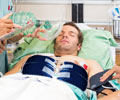Hands-Only CPR Training Kiosks, a novel innovation, have been developed to train people to perform CPR on cardiac arrest patients outside the hospital. This technology has a huge potential to save many lives.
- A novel type of kiosk called Hands-Only CPR Training Kiosk has been developed to train people to perform cardiopulmonary resuscitation (CPR) on cardiac arrest patients outside the hospital.
- The Hands-Only CPR Training Kiosks have the potential to prevent the deaths of many cardiac arrest patients
Read More..
What is a Hands-Only CPR Training Kiosk?
A Hands-Only CPR Training Kiosk is a stand-alone computerized installation that provides easy step-by-step instructions on how to perform cardiopulmonary resuscitation (CPR) on a cardiac arrest patient. The interactive kiosk has a touch screen with a video program that provides a brief overview of the CPR procedure. This is followed by a practice session and a 30-second CPR test, where the operator uses a manikin or rubber torso. During the practice session, the kiosk continuously provides feedback on factors that impact the efficacy of the CPR procedure. These include information about the rate and depth of compressions, as well as proper hand-positioning.Study Objective
The major objective of the study was to compare the efficacy of three methods of Hands-Only CPR:- Classroom session with an expert
- Video only session
- Kiosk session with a manikin
“For a person with little or no medical training, Hands-Only CPR Training Kiosks can teach life-saving skills in just minutes,” said Dr. Debra G. Heard, PhD, affiliated to the American Heart Association and American Stroke Association, Dallas, Texas, USA, and lead author of the study. “These kiosks have the potential to lower barriers to training, increase the likelihood a bystander would perform CPR and positively impact the likelihood of survival from cardiac arrest outside of a hospital.”
Study Design
This was a randomized, controlled study that included 738 participants. The study compared the participant scores on three Hands-Only CPR training methods, indicated below:- Classroom: This involved education by an expert in a classroom setting, with a 25- to 45-minute practice session
- Video Only: This involved watching a 1-minute video on the topic
- Kiosk: This involved a 4-minute on-screen feedback and practice session
Reason for Low Rates of Bystander CPR
It has been observed that only 45.7% adults suffering a cardiac arrest outside of hospital receive CPR from bystanders. This is even lower in rural areas and within minority and low-income groups.The researchers note that the main reason for low rates of bystander CPR is the lack of training. Some of the major roadblocks for CPR training include the following:
- Lack of time
- Lack of access
- Cost factor
- Reluctance to perform mouth-to-mouth resuscitation
Study Findings
The study findings indicated that those who participated in the kiosk session were able to perform Hands-Only CPR as efficiently as those who participated in the classroom session. It was noted that the level of skills of the participants in both these groups were superior to the video only group. The researchers felt that the video session was more suitable for creating awareness, rather than providing actual training.In this regard, Dr. Heard said: “Public health professionals should advocate for regular classroom or kiosk training and re-training.”
Future Potential of Hands-Only CPR Training Kiosks
In 2013 a single Hands-Only CPR Training Kiosk was initially installed as a pilot project at the Dallas-Fort Worth International Airport (DFW), USA. This was followed-up in 2016 by the installation of 5 Hands-Only CPR Training Kiosks jointly by the American Heart Association and the Anthem Foundation, a philanthropic organization. Since then, these kiosks have become very popular and have attracted over 23,000 visitors, without the need for any advertisement.Currently, these kiosks have been installed at 16 airports and 14 other public places across the US. Moreover, it is noteworthy that over 100,000 people have completed training so far. Therefore, these kiosks seem to have a huge potential in the future for saving lives outside the hospital setting.
Source of Funding
The study was funded by the American Heart Association and the Anthem Foundation, USA.Reference:
- Hands-Only Cardiopulmonary Resuscitation Education: A Comparison of On-Screen with Compression Feedback, Classroom, and Video Education - (https://doi.org/10.1016/j.annemergmed.2018.09.026)
Source-Medindia















